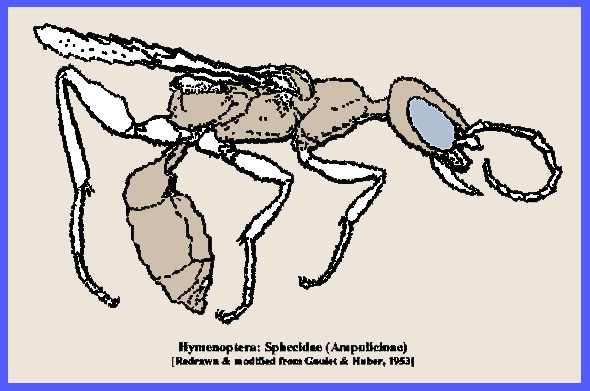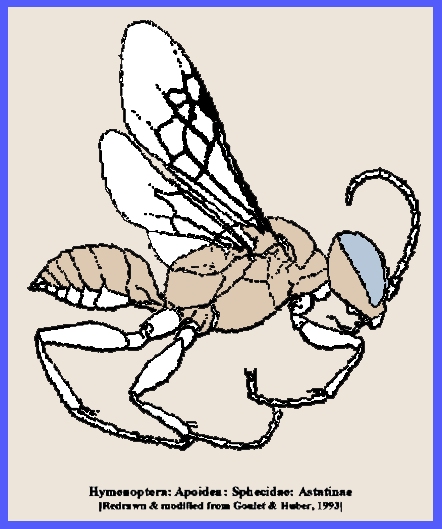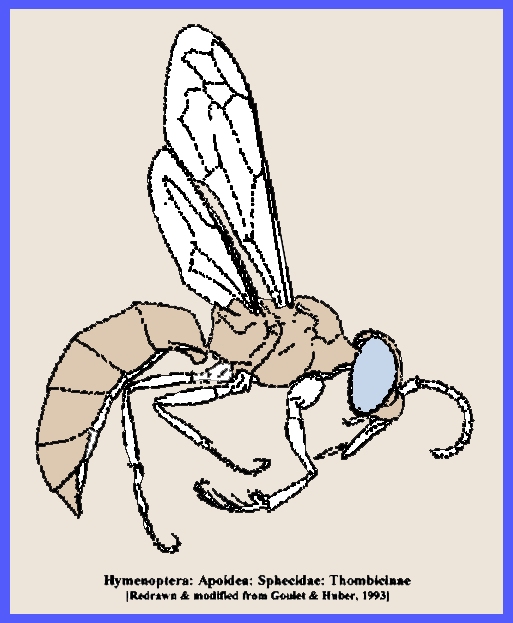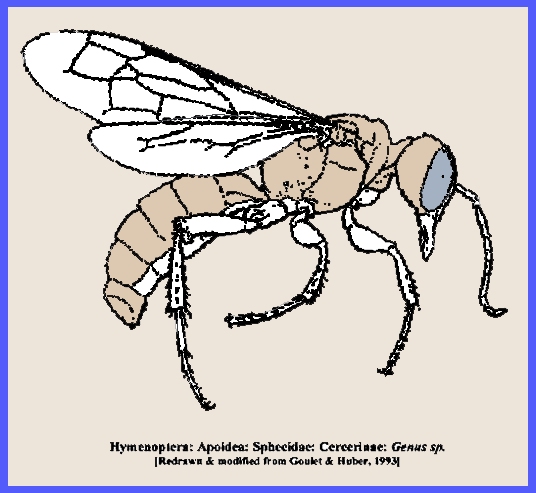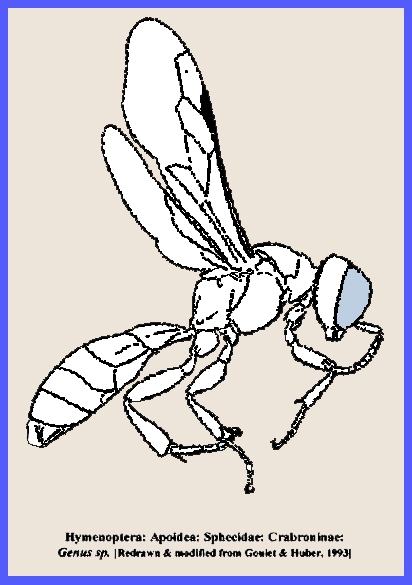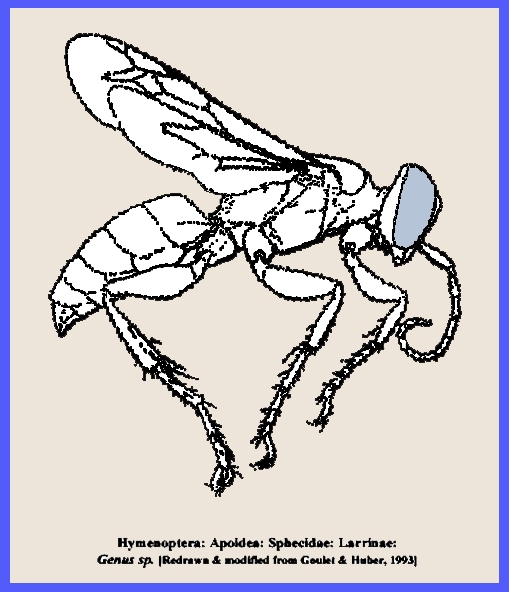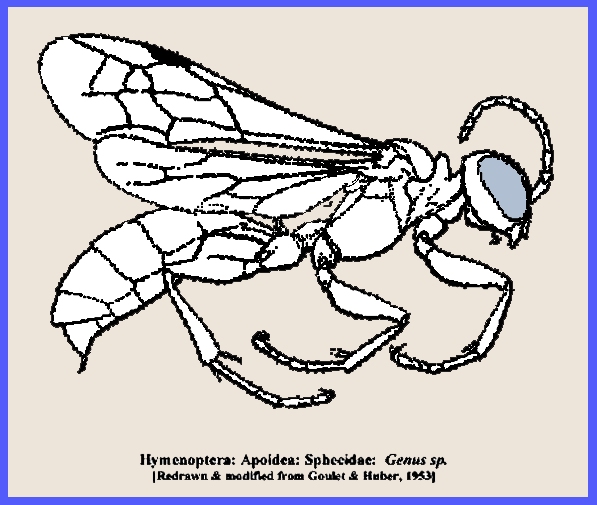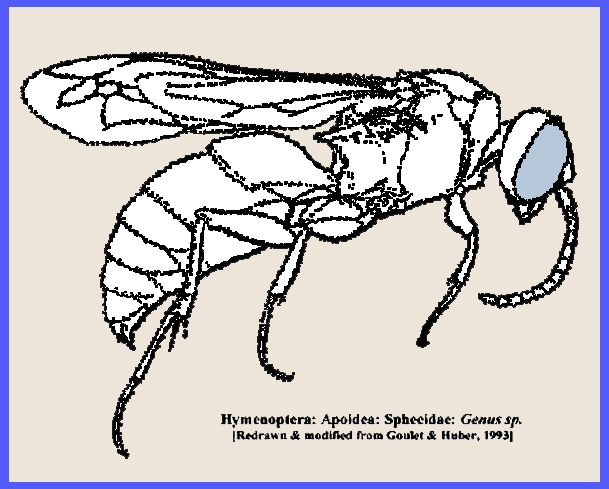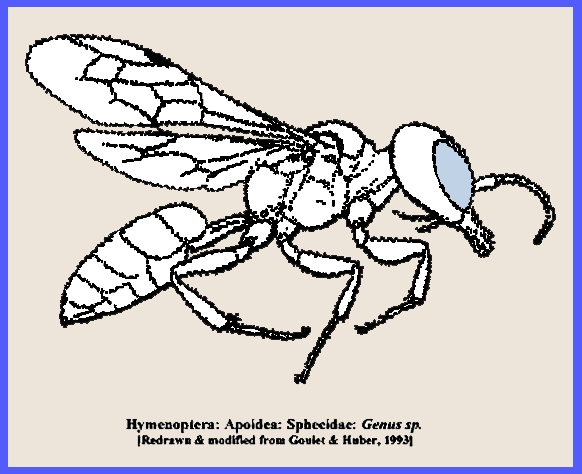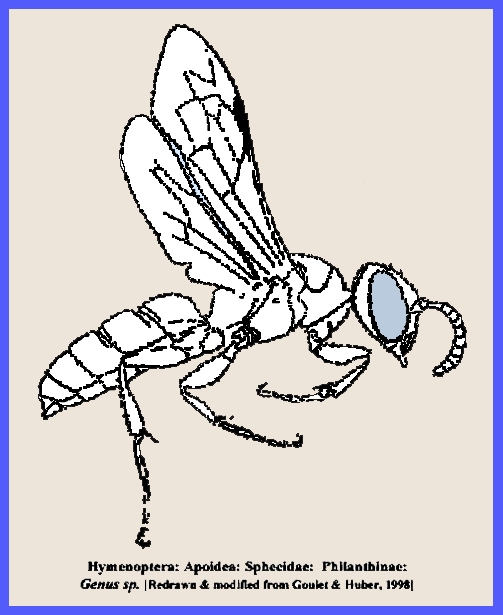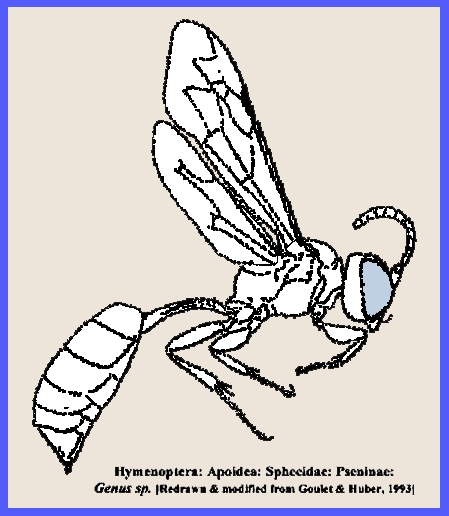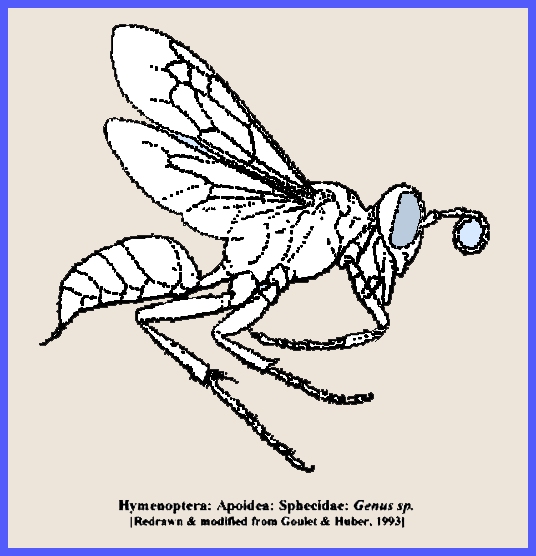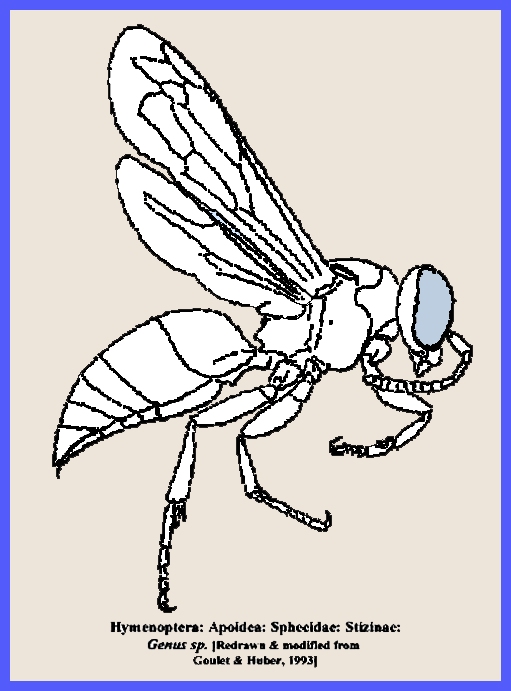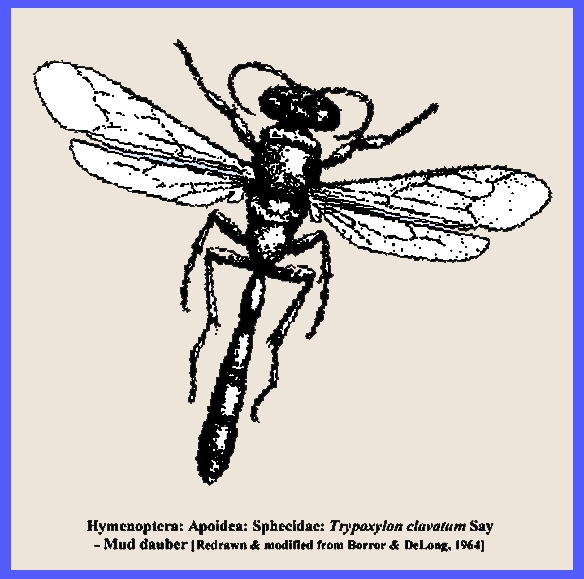File: <sphecidaesub.htm> <Citations> Related
Websites GENERAL INDEX Main Menu
|
SUBFAMILIES of:
Hymenoptera: Sphecidae (Contacts) Please CLICK on Subfamily name to direct:
More information may be found at each: Habits; Adults Juveniles Sphecidae (Sphecoidea) Habits; Adults Juveniles -------------------------------- Ampulicinae. -- Habits;
Adults Juveniles The
subfamily Ampulicinae contains species that seldom dig burrows, but rather utilize
natural cavities for nests, which are provisioned with immature
cockroaches. Williams (1919b)
described the behavior of Dolichurus
stantoni Ashm., which attacks
nymphs of several genera of cockroaches.
The agile cockroaches are located by the female who grasps one by a
cercus or leg, and then stings it in the throat or thorax. As only partial paralysis ensues, the
cockroach is able to continue slow movement.
Then the wasp grasps an antenna near the base and leads or drags the
prey to the nest (Clausen 1940/1962).
The female positions the prey in the nest, and lays an egg rather
obliquely on one of the middle coxae.
After hatching in 1-2 days, the larval feeding period is completed in
4-5 days. D. stantoni
as introduced to Hawaii from the Philippines in 1917 and became well
established. -------------------------------- Astatinae. -- Habits; Adults Juveniles The family is
distributed worldwide except in Australasia and has around 154 species in 6
genera as of 2000. Finnamore & Michener
(1993) noted the subfamilies:
Astatinae, Dinetinae and Laphyragoginae. Adults nest in the soil, and these are supplied with true
bugs. There are about 35 species in
North America Finnamore & Michener (1993). Astatine wasps are a cosmopolitan group of solitary
wasps. The largest genus in this subfamily is Astata, peculiar for their males having very large
compound eyes that broadly meet at the top of the head. -------------------------------- Bembicinae. -- Habits; Adults Juveniles Species of the
subfamily Bembicinae construct their nests in the soil, storing them with
adult flies, such as Syrphidae and Tabanidae. A few species are known to prey on Orthoptera, and there are
records of other insect groups serving as food for Bembex broods (Wheeler & Down 1933). An African species of Bembex was found to attack lycaenid
butterflies, and another Bembex sp.
in Australia captures adult damselflies for its brood. The latter was presumed to be a temporary
measure made necessary by the absence of the normal food insects. Larvae are fed freshly killed prey
throughout their development. -------------------------------- Cercerinae. -- Habits; Adults Juveniles Williams (1919b) observed that Cerceris angularis Ckll. in the Philippines stores its nests
principally with long-horned beetles, while C.
spiniger Roh. shows a
preference for Chrysomelidae. In both
species, the contents of the cells sometimes comprise representatives of both
families. The egg is attached
longitudinally to one beetle's venter.
The prey of Cerceris is
usually stung in the cervix and while being carried to the nest is grasped by
the neck or thorax with only the mandibles.
P. Marchal (Clausen 1940/1962) noted the extensive malaxation of the
throat of bees of the genus Halictus
by C. rybiensis L. (= ornata Marchal) and the extensive
feeding that took place on fluids exuding from the puncture -------------------------------- Crabroninae. -- Habits; Adults Juveniles The subfamily
Crabroninae contains a large number of species of small parasitoids that
build their nests in hollow stems, burrows in the soil or abandoned wood
galleries. The latter are usually
those of beetle borers, and may be further enlarged by the new occupant to
provide cells for its brood. The
nests are of two types, one being linear and consisting of a row of cells,
the second having lateral galleries branching from the main tunnel. Prey are exceedingly varied, ranging from
mites and spiders to adult Coleoptera, Diptera, Homoptera, Ephemeroptera,
Lepidoptera, Hymenoptera and Diptera (Clausen 1940/1962). The subfamily is not wholly beneficial
because of the attack on spiders and some parasitic and predaceous
Hymenoptera and Diptera. Syrphid
flies are frequently attacked, and in Europe Lindenius
pygmaeus Rossi provisions its
cells with chalcidoids of the genus Pteromalus. There is no obvious consistency in the
selection of prey by the various species, as the species of a single genus
may utilize Diptera, Hymenoptera or Coleoptera. A single parasitoid species may limit itself to only one sex of
the host, while the opposite extreme is found in examples of species preying
on several orders (Hamm & Richards 1926). -------------------------------- Larrinae. -- Habits; Adults Juveniles All of the American
genera of Larrinae are ground nesting but one extralimital genus is known to
nest in twigs. The North American species prey upon various Orthoptera.
However, no prey preference has been reported for our single species of Prosopigastra; in Europe some species of
the genus prey upon Hemiptera and Homoptera. One extralimital genus preys
upon lepidopterous larvae. -------------------------------- Mellininae. -- Habits; Adults Juveniles Mellininae is a small
subfamily about which not much is known.
There are only 17 described species in two genera. Several species make their burrows in
sandy locations and provision them with adult Diptera (Clausen 1940/1962). -------------------------------- Nyssoninae. -- Habits; Adults Juveniles There are relatively
few genera and species in the subfamily Nyssoninae. Their prey consists mainly of Homoptera, especially Cercopidae
and Membracidae. Gorytes costalis
Cress. utilizes adults of several genera and each of the several cells in the
nest in the soil is provisioned with 3-6 tree hoppers. These are permanently paralyzed and die
within a week, which usually is the time between laying of the wasp egg and
completion of larval feeding. G. brasiliensis
Shuck. is similar in its habits, but provisions its nests with various
Fulgoridae in South America (Clausen 1940/1962). -------------------------------- Pemphredoninae. -- Habits; Adults Juveniles Members of the
subfamily Pemphredonidae construct galleries in twigs or wood, sometimes
using the abandoned galleries of wood-boring insects, and store their brood
cells with aphids. Other species prey
on other small Homoptera. The nesting
behavior of Stigmus americanus Pack. was studied by Peckham
& Peckham (1895). This species a
enlarges old burrows in decaying wood.
Several wasps may utilize the same gallery, though they nest separately. Each well, when complete, contains about
24 dead aphids, mixed with grains of pith, and the egg is laid on the body of
one of these prey. -------------------------------- Philanthinae. --
Habits; Adults Juveniles This subfamilly is one of
the largest groups in the Sphecidae, although there are only 9 identified
genera. The subfamily has also been given family status at times. Members are
solitary, predatory wasps, each genus with a unique prey preferences.
Mature females dig tunnels in the ground to nest. As with all
other sphecoid wasps, the larvae are carnivorous, and females seek prey on
which to lays their eggs. They
provision the nest cells with paralyzed, living prey that the larvae feed on. The
notorious "bee wolf," Philanthus
triangulum F. (= apivorus Latr.) is of special concern to
bee keepers in some parts of Europe.
An extended account of this insect in relation to honeybees was
presented by Fabre (1891). Female Philanthus kills the adult bee by
stinging it in the throat, after which she begins an extensive malaxation of
the throat by means of which the honey in the crop is forced up to the mouth,
where it is consumed. Alternate
malaxation and feeding may continue for more than an hour. Then the prey is dragged to the burrow,
which extends 1 m or more into the soil and ends in a group of cells, in one
of which the bee is placed. The egg
is then laid ventrally on the thorax.
Clausen (1940) mentioned that it is believed that the larvae are not
able to mature on bees which have not been deprived of honey. A much larger number of bees is killed
than can be used for stocking the nest. -------------------------------- Pseninae. --
Habits; Adults Juveniles The subfamily is small, members
provisioning their nests with Homoptera.
The behavior of Psen barthi Vier., that provisions its nest
with adult leafhoppers, was studied by Barth (1907). The latter are
grasped by the neck or thorax with the middle legs and held with the venter
or side up, when being carried to the nest.
The nest is situated in an old log and comprises a small number of
cells, in each of which 3-5 leafhoppers are placed, the latter probably being
killed by stinging during capture.
The egg is attached to the thorax of one of the leafhoppers in the
cell. Williams (1919c) recorded
similar behavior in Nesomimesa hawaiiensis Perk. Clausen (1940) noted that P. pallidipes
Panz. (= atratus Panz.) stored
its nests with 25-30 paralyzed aphids.
Nests are constructed in May, which continues until the season's end. -------------------------------- Sphecinae. --
Habits; Adults Juveniles Most species of Sphecinae construct their
nests in the soil, although some also form them in hollow stems or construct
mud cells on foliage, etc. Some may
confine themselves to a single host species, while others may attack
individuals of several related families.
The pey varies, ranging from spiders to grasshoppers, mole crickets,
locusts, lepidopterous larvae and cockroaches. Among the common genera, Sceliphron
and Chalybion store their nests
with spiders. C. cyaneum
Dahlb. of North America utilizes the black widow spider. Chlorion, Podium, and Trigonaspis
prey on a variety of Orthoptera; some species of Sphex attack larger Orthoptera, mainly grasshoppers;
others of the genus store their nests with larvae of Lepidoptera. -------------------------------- Stizinae. --
Habits; Adults Juveniles Members of the subfamily Stizinae prey on
Homoptera and Orthoptera. There are
relatively few species. The large cicada
killer, Sphecius speciosus Drury is one of the more common species in North
America. it stores its nests with
adults of the periodical cicada, Magicicada
septendecim L. (Riley
1892). Wasps appear in the field in
July and August. The cicada is completely
paralyzed by the sting, but it has been found that they will, under right
conditions, persist in good physical conditions for more than one year. The prey is of such a large size that the
wasp has difficulty in transporting to the nest. Thus, she adopts an expedient means whereby the prey is dragged
to some height in a tree, after which she glides with it as far as possible
toward the nest. The procedure may be
repeated several times until the nest is reached. Sometimes two cicadas are placed in a single cell, but usually
only one. The egg is laid at one side
of the thoracic venter, and hatching ensues in 2-3 days, with larval feeding
completed in a week. The cocoon is
spun in the cell in the soil and is conspicuous by having two irregular rows
of "pores" at one side which are thought to serve for ventilation
(Clausen 1940/1962). -------------------------------- Trypoxylinae. --
Habits; Adults Juveniles In the subfamily Trypoxyloninae, nests
are often constructed of a large number of mud cells, arranged often in
tubular form on a solid surface. Each
aggregation may comprise the cells of a number of successive
generations. Other species use
crevices or holes in walls, stems, etc., or they may burrow in soil. Almost always they provision their cells
with spiders (Clausen 1940/1962). Peckhams
(1895, 1898) studied Trypoxylon
rubrocinctum Peck. and T. albopilosum
Fox, where females utilize existing burrows in woodwork or masonry that have
been abandoned. T. rubrocinctum
provisions its cells with 7-12 spiders, while T. albopilosum,
being larger, requires 25-30. Prey
may represent many genera and even families, although the majority usually
are in the Epeiridae. An egg is laid
on the side of the abdomen's dorsum of the last spider placed in the cell
(Clausen 1940/1962). -------------------------------- References: Please
refer to
<biology.ref.htm> |
